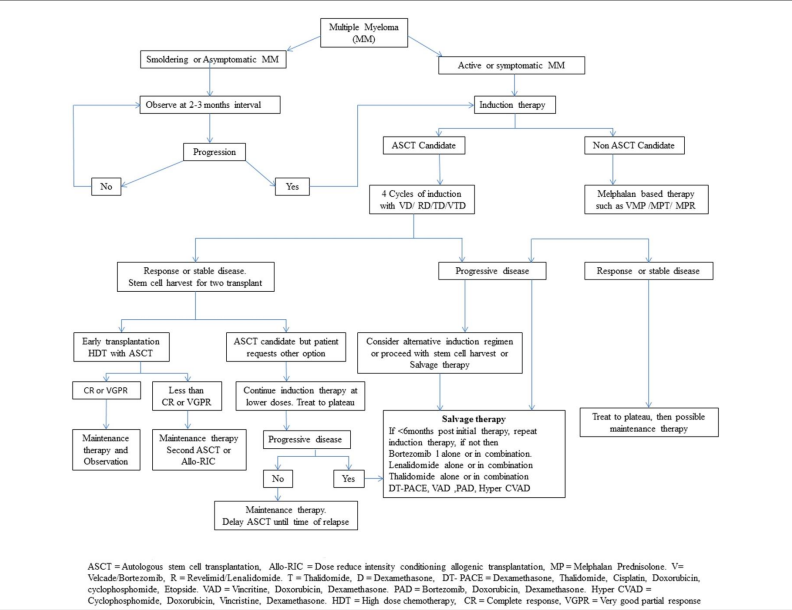Sandbox: treatment
|
Multiple myeloma Microchapters |
|
Diagnosis |
|---|
|
Treatment |
|
Case Studies |
|
Sandbox: treatment On the Web |
|
American Roentgen Ray Society Images of Sandbox: treatment |
Editor-In-Chief: C. Michael Gibson, M.S., M.D. [1]
Overview
Pharmacological regimes for patients with active (symptomatic) multiple myeloma include steroid therapy, immune modulator therapy, and chemotherapy. Whereas patients with smoldering (asymptomatic) multiple myeloma are managed by observation and undergoing follow up tests every 3 to 6 months. The optimal therapy for active multiple myeloma depends on whether or not a patient is eligible for bone marrow transplantation. Pharmacologic medical therapy for active multiple myeloma patients who are eligible for a bone marrow transplant include either dexamethasone, lenalidomide, bortezomib, thalidomide, carfilzomib, cyclophosphamide, vincristine, or doxorubicin. In addition to the aforementioned agents, pharmacological regimes used for treatment of active multiple myeloma patients who are not eligible for a bone marrow transplant include either melphalan or prednisone. Alkylating agents are not recommended among transplant eligible patients, as the toxicity of such agents makes the harvest process of bone marrow stem cell difficult later in the course of the disease.
Medical Therapy
Smoldering multiple myeloma
- Patients with smoldering (asymptomatic) multiple myeloma are managed by observation and follow up tests every 3 to 6 months.
- Follow up tests of asymptomatic multiple myeloma patients include:
- Laboratory studies such as complete blood count, electrolytes, 24 hour urine collection, electrophoresis, and quantitative immunoglobulin analysis
- Imaging studies such as skeletal survey, MRI, and PET scan
- Flow cytometry as needed
- Bone marrow aspiration and biopsy as needed
- Treatment should be differed until such patients develop symptoms.
Active multiple myeoloma
- The optimal therapy for active multiple myeloma depends on whether or not a patient is eligible for bone marrow transplantation.
- Deciding whether a patient is a candidate for bone marrow transplantation depends on a number of key factors that include:
- Type of chromosomal mutation
- Age
- Presence of current associated diseases
- Patient's liver function
- Patient's kidney function
Initial therapy
Bone marrow transplant eligible patients
- Preferred pharmacological regimes for treating such patients include:
- Bortezomib/dexamethasone
- Bortezomib/dexamethasone/lenalidomide
- Dexamethasone/lenalidomide
- Bortezomib/dexamethasone/doxorubicin
- Bortezomib/dexamethasone/thalidomide
- Bortezomib/dexamethasone/cyclophosphamide
Bone marrow transplant ineligible patients
- Preferred pharmacological regimes for treating such patients include:
- Bortezomib/dexamethasone
- Low dose dexamethasone/lenalidomide
- Melphalan/prednisone/thalidomide
- Melphalan/prednisone/bortezomib
Supportive therapy
- Supportive therapy is recommended based on patient's symptoms and medication's side effect.
- Supportive therapy for active multiple myeloma includes:
- Bisphosphonates to prevent osteoporosis
- Erythropoietin to prevent anemia
- Vaccines to prevent recurrent infections
- Blood thinners to prevent blood clots
- Plasmapheresis to prevent hyperviscosity and renal failure
Maintenance therapy
- After a few months of induction therapy the advantages of continuing the same therapy seems to be limited.
- Therefore, this phase is being followed up with maintenance therapy with one of the newer agents such as thalidomide, lenalidomide or bortezomib. *However, further clinical trials are needed to establish the efficacy of each of these agents.
Gallery
